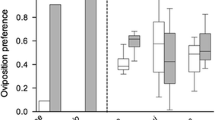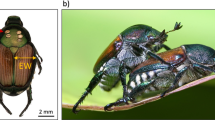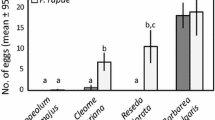Abstract
Although oviposition behavior of butterflies has been studied extensively, physiological parameters that may affect various aspects of female behavior have been overlooked almost completely. The number of mature eggs carried by a female Battus philenorgreatly affects her behavior at any particular time. Females with many eggs search significantly more for host plants than females with fewer eggs, which tend to rest more. Parameters affecting the number of mature eggs are also studied.
Similar content being viewed by others
References
Barker, J. F., and Herman, W. S. (1973). On the neuroendocrine control of ovarian development in the monarch butterfly.J. Exp. Zool. 183: 1–10.
Barker, J. F., Herman, W. S. (1976). Effect of photoperiod and temperature on reproduction of the monarch butterfly,Danaus plexippus.J. Insect Physiol. 22: 1565–1568.
Chew, F. S. (1977). Coevolution of pierid butterflies and their cruciferous foodplants. II. The distribution of eggs on potential foodplants.Evolution 31: 568–579.
Courtney, S. P. (1981). Coevolution of pierid butterflies and their cruciferous foodplants. III.Anthocaris cardamines (L.) survival, development and oviposition on different hostplants.Oecologia (Berl.) 51: 91–96.
Courtney, S. P., and Duggan, A. E. (1983). The biology of the orange tip butterflyAnthocaris cardamines in Britain.Ecol. Entomol. 8: 271–281.
David, W. A. L., and Gardiner, B. O. C. (1962). Oviposition and the hatching of the eggs ofPieris brassicae (L.) in a laboratory culture.Bull. Entomol. Res. 53: 91–109.
Dunlap-Pianka, H. L. (1979). Ovarian dynamics inHeliconius butterflies: Correlations among daily oviposition rates, egg weights, and quantitative aspects of oogenesis.J. Insect Physiol. 25: 741–749.
Ehrlich, A. H., and Ehrlich, P. R. (1978). Reproductive strategies in the butterflies. I. mating frequency, plugging, and egg number.J. Kans. Entomol. Soc. 51(4): 666–697.
Gossard, T. W., and Jones, R. E. (1977). The effects of age and weather on egg-laying inPieris rapae L.J. Appl. Ecol. 14: 65–71.
Grossmueller, D. W., and Lederhouse, R. C. (1985). Oviposition site selection: An aid to rapid growth and development in the tiger swallowtail butterfly,Papilio glaucus.Oecologia 66: 68–73.
Hayes, J. L. (1981). The population ecology of a natural population of the pierid butterflyColias alexandra.Oecologia 49: 188–200.
Herman, W. S. (1973). The endocrine basis of reproductive inactivity in monarch butterflies over-wintering in central California.J. Insect Physiol. 19: 1883–1887.
Iwasa, Y., Odendaal, F. J., Murphy, D. D., Ehrlich, P. R., and Launer, A. L. (1983). Emergence patterns in male butterflies: A hypothesis and a test.Theor. Pop. Biol. 23: 363–379.
Jones, P. M. (1977). Movement patterns and egg distributions in cabbage butterflies.J. Anim. Ecol. 46: 195–212.
King, R. C., Burnett, R. G., and Staley, N. A. (1957). Oogenesis inDrosophila melanogaster. IV. Hereditary ovarian tumors.Growth 21: 239–261.
Kingsolver, J. G. (1983). Thermoregulation and flight inColias butterflies: Elevational patterns and mechanistic limitations.Ecology 64: 534–545.
Ma, W. G., and Schoonhoven, L. M. (1973). Tarsal contact chemosensory hairs of the large white butterflyPieris brassicae and their possible role in oviposition behavior.Entomol. Exp. Appl. 16: 343–357.
Murphy, D. D., Launer, A., and Ehrlich, P. R. (1983). The role of adult feeding in egg production and population dynamics of the checkerspot butterfly,Euphydryas editha.Oecologia 56: 257–263.
Odendaal, F. J., Rausher, M. D., Benrey, B., and Nunez-Farfan, J. (1987). Predation byAnolis lizards onBattus philenor raises questions about butterfly mimicry systems.J. Lepid. Soc. 41(3) (in press).
Papaj, D. R. (1986). Shifts in foraging behavior by aBattus philenor population: Field evidence for switching by individual butterflies.Behav. Ecol. Sociobiol. (in press).
Rausher, M. D. (1978). Search image for leaf shape in a butterfly.Science 200: 1071–1073.
Rausher, M. D. (1979). Egg recognition: Its advantage to a butterfly.Anim. Behav. 27: 1034–1040.
Rausher, M. D. (1979b). Larval habitat suitability and oviposition preference in three related butterflies.Ecology 60: 503–511.
Rausher, M. D. (1980). Host abundance, juvenile survival, and oviposition preference inBattus philenor.Evolution 34: 342–355.
Rausher, M. D. (1983). Alteration of oviposition behavior byBattus philenor butterflies in response to variation in host plant density.Ecology 64: 1028–1034.
Rausher, M. D. (1985). Variability for host preference in insect populations: Mechanistic and evolutionary models.J. Insect Physiol. 31(11): 873–889.
Rausher, M. D., and Papaj, D. R. (1983). Host plant selection byBattus philenor butterflies: Evidence for individual differences in foraging behaviour.Anim. Behav. 31: 341–347.
Rausher, M. D., and Odendaal, F. J. (1987). Switching and the pattern of host use byBattus philenor.Ecology 68: 869–877.
Rothschild, M., and Schoonhoven, L. M. (1977). Assessment of egg load byPieris brassicae (Lepidoptera, Pieridae).Nature 266: 352–355.
Shapiro, A. M. (1980). Egg-load assessment and carryover diapause inAnthocaris (Pieridae).J. Lepid. Soc. 34: 307–315.
Singer, M. C. (1971). Evolution of food plant preferences in the butterflyEuphydryas editha.Evolution 25: 383–389.
Singer, M. C. (1982). Quantification of host preference by manipulation of oviposition behavior in the butterflyEuphydryas editha.Oecologia (Berl.) 52: 224–229.
Singer, M. C. (1983). Determinants of multiple host use by a phytophagous insect population.Evolution 37: 389–403.
Stern, V. M., and Smith, R. F. (1960). Factors affecting egg production and oviposition in populations ofColias philodice eurytheme Boisduval (Lepidoptera: Pieridae).Hilgardia 29(10): 411–454.
Streng, D. R., and Harcombe, P. A. (1982). Why don't east Texas savannas grow up to a forest?Am. Midl. Nat. 108: 278–294.
Vogl, R. J. (1972). Fire in the southeastern grasslands.Tall Timbers Fire Ecol. Conf. 12: 175–198.
Watt, W. B., Chew, F. S., Snyder, L. R. G., Watt, A. G., and Rothschild, D. E. (1977). Population structure of Pierid butterflies. I. Numbers and movements of some montaneColias species.Oecologia 27: 1–22.
Wiklund, C. (1975). The evolutionary relationship between adult ovipostion preference and larval host range inPapilio machaon L.Oecologia (Berl.) 18: 185–197.
Williams, K. S. (1983). The coevolution ofEuphydryas chalcedona butterflies and their larval host plants. III. Oviposition behavior and host plant quality.Oecologia (Berl.) 56: 335–340.
Williams, K. S., and Gilbert, L. E. (1981). Insects as selective agents on plant vegetative morphology: Egg mimicry reduces egg laying by butterflies.Science 212: 467–469.
Author information
Authors and Affiliations
Rights and permissions
About this article
Cite this article
Odendaal, F.J. Mature egg number influences the behavior of femaleBattus philenor butterflies. J Insect Behav 2, 15–25 (1989). https://doi.org/10.1007/BF01053615
Accepted:
Issue Date:
DOI: https://doi.org/10.1007/BF01053615




